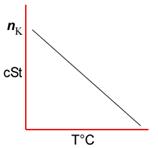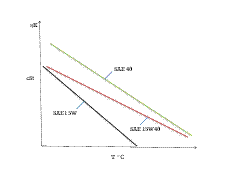MONOGRADE VS MULTIGRADE ENGINE OILS
Introduction
An engine oil fulfills a number of crucial functions and failing in any one of them, may be catastrophic. A good engine oil must be able to hold in suspension contaminants such as carbon (soot) particles, by-products of fuel combustion, neutralize organic acids, protect against rust and corrosion and dissipate the heat generated from the combustion cycle. And it must do all of these things under tremendous heat and pressure without succumbing to fatigue. Yet the most important function of a lubricant is to lubricate and reduce friction.
This function is performed by the oil film formed between two moving parts and its load carrying ability and is described as the oil’s viscosity. In the common engineering sense, viscosity is the resistance to flow or “thickness” of a liquid. The viscosity decreases with an increase in temperature, hence the temperature at which a viscosity is measured, must always be specified. There are several viscosity units but the one most frequently used is the Centistoke (cSt), which is the derived unit of kinematic viscosity where 1 cSt = 1 mm²/s.
Crankcase Oil Classifications
The most widely used system for engine oil classification is that established by the Society of Automotive Engineers (SAE) in the USA.
In this system, two series of viscosity grades are defined – those containing the letter “W” and those without it. Grades with the letter “W” are intended for use at lower temperatures and are based on a maximum low temperature viscosity and a maximum borderline pumping temperature, as well as a minimum viscosity at 100°C. The low temperature viscosity is measured by means of a multi-temperature version of ASTM D2602. This test describes the method for apparent viscosity of motor oils at low temperature using the Cold Cranking Simulator. Viscosities measured by this method have been found to correlate with engine speeds developed during low temperature cranking. Borderline pumping temperature is measured according to ASTM D3829. This provides a measure of an oil’s ability to flow to the oil pump and provide adequate pressure during the initial stages of operation. Oils without the letter
”W”, intended for use at higher temperatures, are based on the viscosity at 100°C only. These are measured by ASTM D445. Fig. 1 depicts the SAE J300 classification for engine oils.
Automotive Lubricant Viscosity Grades |
|||||
SAE |
Low Temperature Viscosities |
High-Temperature Viscosities |
|||
Viscosity |
Cranking (mPa/s) |
Pumping (mPa/s) |
Kinematic |
High Shear Rate (mPa/s) |
|
|
|
|
min |
max |
min |
0W |
6200 at -35 |
60 000 at -40 |
3.8 |
— |
— |
5W |
6600 at -30 |
60 000 at -35 |
3.8 |
— |
— |
10W |
7000 at -25 |
60 000 at -30 |
4.1 |
— |
— |
15W |
7000 at -20 |
60 000 at -25 |
5.6 |
— |
— |
20W |
9500 at -15 |
60 000 at -20 |
5.6 |
— |
— |
25W |
13 000 at -10 |
60 000 at -15 |
9.3 |
— |
— |
20 |
— |
— |
5.6 |
<9.3 |
2.6 |
30 |
— |
— |
9.3 |
<12.5 |
2.9 |
40 |
— |
— |
12.5 |
<16.3 |
2.9 |
40 |
— |
— |
12.5 |
<16.3 |
3.7 |
50 |
— |
— |
16.3 |
<21.9 |
3.7 |
60 |
— |
— |
21.9 |
<26.1 |
3.7 |
Fig.1 SAE J300 – Automotive Engine Oil Classifications
Monograde Oils
Monograde oils, as defined by the SAE J300 classification system, cover a single requirement and cannot use a polymeric viscosity index improver (also referred to as a viscosity modifier). SAE J300 has established eleven viscosity grades see fig.1, of which six are considered Winter-grades and given a “W” designation. For single winter grade oils, the dynamic viscosity is measured at different cold temperatures, specified in J300 depending on the viscosity grade, in units of mPa/s. Based on the coldest temperature the oil passes at, that oil is graded as SAE viscosity grade 0W, 5W, 10W, 15W, 20W, or 25W. The lower the viscosity grade, the lower the temperature the oil can pass. For example, if an oil passes at the specifications for 10W and 5W, but fails for 0W, then that oil must be labeled as an SAE 5W. It cannot be labeled as either 0W or 10W.
For non-winter grade oils, the kinematic viscosity is measured at a temperature of 100 °C in units of mm²/s or the equivalent centistokes. Based on the range of viscosity the oil falls in at that temperature, the oil is graded as SAE viscosity grade 20, 30, 40, 50, or 60. In addition, for SAE grades 20, 30, and 40, a minimum viscosity measured at 150 °C and at a high-shear rate is also required. The higher the viscosity, the higher the SAE grade is.
Remember that for any oil, if temperature is increased, viscosity will decrease. See Fig. 2

Fig.2 Viscosity/Temperature Graph
The viscosity is high at low temperatures and low at high temperatures.
However, not all oils behave in the same manner. Some oils thin out less than others when the temperature is increased. This is the difference between a monograde and a multigrade oil.
Multigrade Oils
As opposed to monograde oils which cover a single requirement as stipulated by the SAE J300 classification system, multigrade oils meet the requirements of more than one SAE grade and may therefore be suitable for use over a wider temperature range than a monograde oil. Multigrade oils are made by blending a low-viscosity oil with special additives called Viscosity Index Improver (VII) VII are additives which improve the temperature/viscosity characteristics of oils. Oils containing these additives, combine the good starting and friction properties of a thin oil at low temperatures with the good lubricating properties of a more viscous oil at high temperatures. See Fig. 3

Fig. 3 Viscosity Index Improvers
The mechanism by which these polymers work, is that at low temperature, they curl themselves up into a tight ball that moves freely with the oil molecules. As the temperature increases though, they expand into a large stringy structure which restricts the normal flow of the oil. As the temperature reduces, they go back to their original shape. The result is that for example, when these polymer additives are blended in the correct proportion with an SAE15W oil, the oil flows like an SAE 15W oil at low temperatures and like an SAE 40 oil at high temperatures. The result is an SAE 15W/40 oil that will provide wide protection over an extended temperature range. See Fig. 4

Fig. 4 Viscosity/Temperature Characteristics of Monograde & Multigrade Oils
Advantages of Multigrade Oils
Disadvantages of Multigrade Oils:
Conclusion
Multigrade oils are the preferred option for all modern engines.
Multigrade oils will keep equipment operating in an optimum viscosity range, and offer consistent response and lubrication protection.
Monograde oils are an acceptable option if the equipment can provide excellent oil cooling and constant temperature control.
Source: http://www.lubricantsonline.co.za/uploads/Monograde%20vs%20Multigrade%20Oils.doc
Web site to visit: http://www.lubricantsonline.co.za
Author of the text: indicated on the source document of the above text
If you are the author of the text above and you not agree to share your knowledge for teaching, research, scholarship (for fair use as indicated in the United States copyrigh low) please send us an e-mail and we will remove your text quickly. Fair use is a limitation and exception to the exclusive right granted by copyright law to the author of a creative work. In United States copyright law, fair use is a doctrine that permits limited use of copyrighted material without acquiring permission from the rights holders. Examples of fair use include commentary, search engines, criticism, news reporting, research, teaching, library archiving and scholarship. It provides for the legal, unlicensed citation or incorporation of copyrighted material in another author's work under a four-factor balancing test. (source: http://en.wikipedia.org/wiki/Fair_use)
The information of medicine and health contained in the site are of a general nature and purpose which is purely informative and for this reason may not replace in any case, the council of a doctor or a qualified entity legally to the profession.
The texts are the property of their respective authors and we thank them for giving us the opportunity to share for free to students, teachers and users of the Web their texts will used only for illustrative educational and scientific purposes only.
All the information in our site are given for nonprofit educational purposes